A) imports 200 carnations.
B) imports 400 carnations.
C) exports 200 carnations.
D) exports 400 carnations.
F) None of the above
Correct Answer

verified
Correct Answer
verified
True/False
The world price of cotton is the highest price of cotton observed anywhere in the world.
B) False
Correct Answer

verified
Correct Answer
verified
Multiple Choice
Which of the following is not an important question for economic policy raised by the experience of the textile industry?
A) How does international trade affect consumer well-being?
B) Who gains and who loses from free trade among countries?
C) How do the gains from trade compare to the losses?
D) Which argument for restricting free trade is politically feasible?
F) All of the above
Correct Answer

verified
Correct Answer
verified
Multiple Choice
The rules established under GATT are enforced by the
A) governments of the nations that are involved in GATT.
B) North American Free Trade Association.
C) World Trade Organization.
D) European Union.
F) A) and B)
Correct Answer

verified
Correct Answer
verified
True/False
William and Jamal live in the country of Dumexia. When Dumexia legalized international trade in bananas, the price of bananas in Dumexia increased. As a result, William became better off and Jamal became worse off. It follows that William is a seller, and Jamal is a buyer, of bananas.
B) False
Correct Answer

verified
Correct Answer
verified
Multiple Choice
Figure 9-16. The figure below illustrates a tariff. On the graph, Q represents quantity and P represents price. 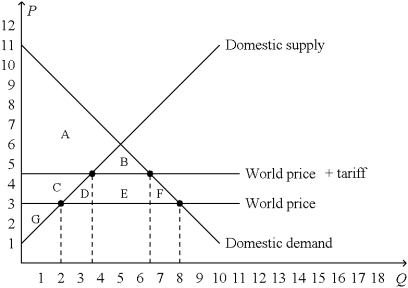 -Refer to Figure 9-16. The tariff
-Refer to Figure 9-16. The tariff
A) decreases producer surplus by the area C, decreases consumer surplus by the area C + D + E, and decreases total surplus by the area D + F.
B) increases producer surplus by the area C, decreases consumer surplus by the area C + D + E + F, and decreases total surplus by the area D + F.
C) creates government revenue represented by the area B + E and decreases total surplus by the area D + E + F.
D) increases producer surplus by the area C + G and creates government revenue represented by the area D + E + F.
F) A) and C)
Correct Answer

verified
Correct Answer
verified
Multiple Choice
Figure 9-6 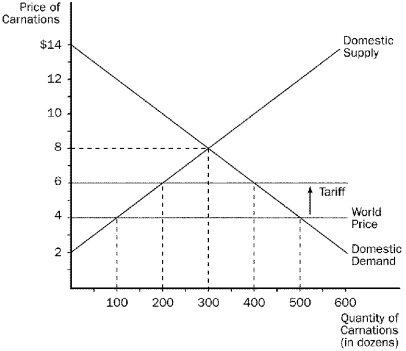 -Refer to Figure 9-6. Without trade, the equilibrium price of carnations is
-Refer to Figure 9-6. Without trade, the equilibrium price of carnations is
A) $8 and the equilibrium quantity is 300.
B) $6 and the equilibrium quantity is 200.
C) $6 and the equilibrium quantity is 400.
D) $4 and the equilibrium quantity is 500.
F) None of the above
Correct Answer

verified
Correct Answer
verified
Multiple Choice
Figure 9-3. The domestic country is China. 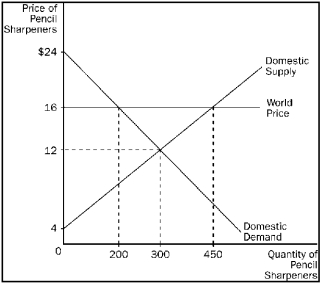 -Refer to Figure 9-3. The increase in total surplus in China when trade is allowed is
-Refer to Figure 9-3. The increase in total surplus in China when trade is allowed is
A) $400.
B) $500.
C) $600.
D) $750.
F) A) and C)
Correct Answer

verified
Correct Answer
verified
Multiple Choice
Figure 9-12 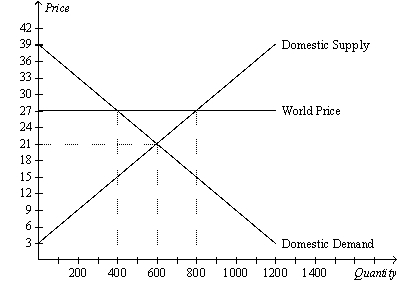 -Refer to Figure 9-12. Producer surplus after trade is
-Refer to Figure 9-12. Producer surplus after trade is
A) $7,000.
B) $7,500.
C) $8,800.
D) $9,600.
F) A) and C)
Correct Answer

verified
Correct Answer
verified
Multiple Choice
Scenario 9-2 For a small country called Boxland, the equation of the domestic demand curve for cardboard is , where represents the domestic quantity of cardboard demanded, in tons, and represents the price of a ton of cardboard.For Boxland, the equation of the domestic supply curve for cardboard is , where represents the domestic quantity of cardboard supplied, in tons, and again represents the price of a ton of cardboard. -Refer to Scenario 9-2. Suppose the world price of cardboard is $60 and international trade is allowed. Then Boxland's consumers demand
A) 110 tons of cardboard and Boxland's producers supply 120 tons of cardboard.
B) 96 tons of cardboard and Boxland's producers supply 96 tons of cardboard.
C) 96 tons of cardboard and Boxland's producers supply 115 tons of cardboard.
D) 80 tons of cardboard and Boxland's producers supply 120 tons of cardboard.
F) All of the above
Correct Answer

verified
Correct Answer
verified
Multiple Choice
Figure 9-5 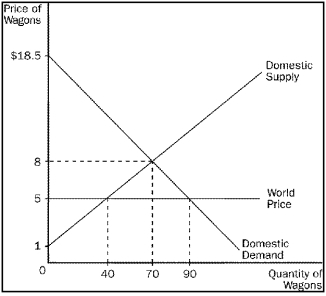 -Refer to Figure 9-5. With trade, the price of wagons in this country is
-Refer to Figure 9-5. With trade, the price of wagons in this country is
A) $8, with 70 wagons produced in this country, 20 of which are exported.
B) $8, with 90 wagons produced in this country, 50 of which are exported.
C) $5, with 40 wagons produced in this country and another 30 wagons imported.
D) $5, with 40 wagons produced in this country and another 50 wagons imported.
F) A) and C)
Correct Answer

verified
Correct Answer
verified
Multiple Choice
If the United States imports televisions and the U.S. government imposes a tariff on televisions, then
A) total surplus in the American television market decreases.
B) producer surplus in the American television market increases.
C) U.S. imports of foreign televisions decrease.
D) All of the above are correct.
F) A) and C)
Correct Answer

verified
Correct Answer
verified
Multiple Choice
Figure 9-12  -Refer to Figure 9-12. Consumer surplus after trade is
-Refer to Figure 9-12. Consumer surplus after trade is
A) $1,600.
B) $2,400.
C) $3,200.
D) $3,600.
F) B) and D)
Correct Answer

verified
Correct Answer
verified
Multiple Choice
A tariff on a product
A) enhances the economic well-being of the domestic economy.
B) increases the domestic quantity supplied.
C) increases the domestic quantity demanded.
D) results in an increase in producer surplus that is greater than the resulting decrease in consumer surplus.
F) B) and C)
Correct Answer

verified
Correct Answer
verified
Multiple Choice
Scenario 9-1 The before-trade domestic price of peaches in the United States is $40 per bushel. The world price of peaches is $52 per bushel. The U.S. is a price-taker in the market for peaches. -Refer to Scenario 9-1. If trade in peaches is allowed, the price of peaches in the United States
A) will increase, and this will cause consumer surplus to decrease.
B) will decrease, and this will cause consumer surplus to increase.
C) will be unaffected, and consumer surplus will be unaffected as well.
D) could increase or decrease or be unaffected; this cannot be determined.
F) A) and D)
Correct Answer

verified
Correct Answer
verified
Multiple Choice
Figure 9-13 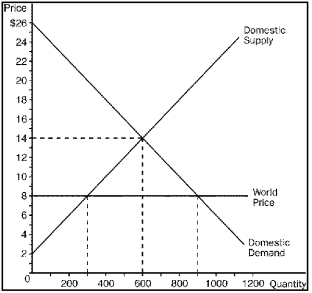 -Refer to Figure 9-13. With trade, producer surplus is
-Refer to Figure 9-13. With trade, producer surplus is
A) $900.
B) $1,100.
C) $1,500.
D) $2,000.
F) B) and C)
Correct Answer

verified
Correct Answer
verified
Multiple Choice
A tariff on a product
A) is a direct quantitative restriction on the amount of a good that can be imported.
B) increases the domestic quantity supplied.
C) increases domestic consumer surplus.
D) All of the above are correct.
F) B) and D)
Correct Answer

verified
Correct Answer
verified
Multiple Choice
When a country allows trade and becomes an importer of a good,
A) both domestic producers and domestic consumers become better off.
B) domestic producers become better off, and domestic consumers become worse off.
C) domestic producers become worse off, and domestic consumers become better off.
D) both domestic producers and domestic consumers become worse off.
F) None of the above
Correct Answer

verified
Correct Answer
verified
True/False
The sum of consumer and producer surplus measures the total benefits that buyers and sellers receive from participating in a market.
B) False
Correct Answer

verified
Correct Answer
verified
Multiple Choice
Figure 9-20
The figure illustrates the market for rice in Vietnam. 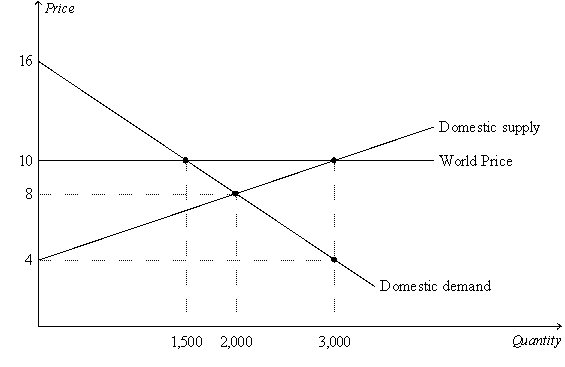 -Refer to Figure 9-20. From the figure it is apparent that
-Refer to Figure 9-20. From the figure it is apparent that
A) Vietnam has a comparative advantage in producing rice, relative to the rest of the world.
B) foreign countries have a comparative advantage in producing rice, relative to Vietnam.
C) Vietnam has an absolute advantage in producing rice, relative to the rest of the world.
D) foreign countries have an absolute advantage in producing rice, relative to Vietnam.
F) B) and D)
Correct Answer

verified
Correct Answer
verified
Showing 101 - 120 of 409
Related Exams